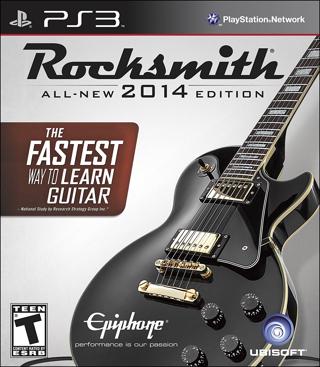Guitar Hero is played with a guitar-shaped controller. The main inputs are the five differently-colored fret buttons and the strum bar. With one hand, the player holds down the fret buttons indicated by the differently-colored on-screen notes (in a simplified approximation of holding down the right strings at the right frets on a real guitar) and with the other hand the player presses the strum bar then when the notes scroll to the right point (in a simplified approximation of strumming the strings on a real guitar).
There are five fret buttons, but if you hold the guitar controller the standard way real guitars are held, your fretting hand wraps around the guitar neck and your thumb is stuck on the back. You’re thus left with only four fingers for the five fret buttons. This is presumably intentional - it forces you to move your hand up and down a little on the neck to press the correct frets, as you’d have to do with a real guitar.
But! This is only true once you get to Hard or Expert level play. On Easy, only the first three fret buttons are ever used. Medium increases it to four, and Hard finally uses all five. This means that the entire time you are playing on Easy or Medium and learning the game, you don’t have to move your fret hand. You are trained that red notes mean pressing your index finger, green ones mean pressing your middle finger, and yellow ones mean pressing your ring finger. (And on Medium, blue notes mean pressing your pinky.)
Then you start playing on Hard. Most songs don’t begin with an orange note, so you play the first several notes the same as you used to, and then an orange note appears. You slide your hand down one fret to press the orange fret button with your pinky. But then when a green note appears, what happens? What you should do is press with your index finger, because you’ve slid your hand one fret down. But you’ve been trained that green means middle finger, so there’s a good chance you’ll press with that instead even though it’s currently over the yellow fret button and you’ll play the wrong note.
For me and for the folks I’ve talked to, by far the hardest part of Hard mode wasn’t the increased density of the note charts or even moving to hit the orange notes. It was unlearning the habits taught by Easy and Medium so that once we had moved to hit the orange notes, we didn’t use the wrong fingers to hit the other notes. It was re-training ourselves to associate note colors not with fingers but with frets so that we could figure out which finger to use based on the fret and the current position of our hand. Once this was done, going up to Expert was comparatively simple.
I remember thinking at the time that while it was obviously correct to keep the note charts sparse for Easy and Medium, all five frets probably should have been used from the beginning. (And I think this is what later games ended up doing? I don’t know - the guitar skills transfer pretty well between games so I haven’t dipped back down to Easy or Medium in a long time.) And I’ve been thinking about this again because I’m on a bit of a rhythm game kick lately and have been seeing how different games treat their difficulty levels.
Guitar Hero’s error (if you consider it an error, as I do) was in treating two kinds of difficulty the same when they were actually very different. The first kind was density of the note chart, which is commonly tied to difficulty levels in rhythm games. This makes sense - a denser note chart requires a higher skill level, so as players get better they need denser charts to maintain flow (which I argue is the point of rhythm games).
While it may seem like the variety of different notes used is another source of difficulty that should scale similarly, I think this is a mistake. Learning the inputs and how they correspond to the game’s cues is most of learning to play the game. Guitar Hero withholding some of the frets from you at the start means it’s training you on an incomplete version of the game. That’s not inherently problematic, but you have to be careful about it or you’ll teach bad habits (like “color = finger” instead of “color = fret” in this case). Much like adding the double-jump in Runner3, adding the orange notes and forcing the player to move their hand doesn’t technically change the meaning of the other color notes, but it does mean that the simplest strategy for dealing with them and thus the one the player has likely internalized is now often incorrect.
The increased challenge of the denser note charts which more closely matched the real song being played and the forced fret-hand movement which more closely matched the hand motions of a real guitarist was good - this added challenge increased flow and immersion. This is a case of what’s hard about the game also being what’s interesting about it.
But challenge that comes from the fact that the game taught the player bad habits isn’t interesting in a game like Guitar Hero. It’s frustrating. You just deal with it until you unlearn the habits and the game can be fun again.




